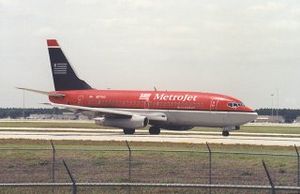- MetroJet
-
This article discusses the former U.S. carrier, not the Hong Kong-based business jet operator.
MetroJet IATA
USICAO
USACallsign
USAIRFounded 1998 Ceased operations 2001 Hubs Baltimore-Washington International Thurgood Marshall Airport Frequent-flyer program Dividend Miles Fleet size 49 Destinations 25 Parent company US Airways Headquarters Arlington, Virginia Key people S. Michael Scheeringa
(Vice President)Website flymetrojet.com MetroJet was a no-frills "airline within an airline" brand operated as a division of US Airways from 1998 to 2001.
Contents
History
After the conclusion of painstaking labor negotiations in 1997, US Airways sought to head off burgeoning competition from low-cost carriers in its strongest region, the U.S. Northeast. Competitor Southwest Airlines was encroaching from its base in the West as were Delta Express and, more importantly, AirTran Airways from the South. Like them it would offer a single class of service, operate a single type of aircraft (the Boeing 737-200), and fly a limited network, based at the airline's Baltimore hub. Like similar projects from traditional carriers, including Continental Lite, Delta Express, and Shuttle by United, it would participate in the parent airline's frequent flyer program and other systems.
MetroJet was launched on June 1, 1998, flying from its base at Baltimore-Washington International Airport to Cleveland, Ohio, Providence, Rhode Island, Fort Lauderdale, Florida, and Manchester, New Hampshire. It began with five dedicated aircraft, repainted in a distinctive livery with a red and gray fuselage, and the traditional blue tail with the US Airways logo. It was slated for a measured expansion over the next two years that eventually included flights from Washington Dulles International Airport and several point-to-point operations, with an emphasis on connecting Northeastern passengers to destinations in Florida.
MetroJet operations did not improve US Airways's loss-making record. Many of MetroJet's passengers were cannibalized from other US Airways operations, such as its major presence at Ronald Reagan Washington National Airport. Its aircraft were among the oldest and least fuel efficient in US Airways's fleet, and like its parent its labor costs were among the highest in the industry. Meanwhile, it faced cutthroat competition with Southwest, its main competitor at BWI. In an October 28, 2001 interview with Business Travel News, CEO David Siegel revealed that MetroJet's average cost per available seat mile was 8 cents, compared to 6 cents for Southwest and 10 cents for mainline US Airways.
The September 11, 2001 attacks gave US Airways a rationale to invoke a force majeure clause in its labor contracts to close the operation, announced on September 24. It represented, too, US Airways's surrender of Baltimore-Washington International Thurgood Marshall Airport as a hub, which it had inherited from an earlier merger with Piedmont Airlines. Once the largest carrier there, its number of scheduled flights had fallen by 60 percent by the time the last MetroJet 737 was retired in December.
Destinations
- Albany (Albany International Airport)
- Atlanta (Hartsfield-Jackson Atlanta International Airport)
- Baltimore (Baltimore-Washington International Thurgood Marshall Airport) Hub
- Birmingham (Birmingham International Airport)
- Boston (Logan International Airport)
- Buffalo (Buffalo Niagara International Airport)
- Chicago (Chicago Midway International Airport)
- Cleveland (Cleveland Hopkins International Airport)
- Columbus (Port Columbus International Airport)
- Fort Lauderdale/Hollywood (Fort Lauderdale-Hollywood International Airport)
- Fort Myers (Southwest Florida International Airport)
- Hartford (Bradley International Airport)
- Jacksonville (Jacksonville International Airport)
- Manchester (Manchester-Boston Regional Airport)
- Miami (Miami International Airport)
- Milwaukee (General Mitchell International Airport)
- New Orleans (Louis Armstrong New Orleans International Airport)
- New York City (LaGuardia Airport)
- Orlando (Orlando International Airport)
- Providence (T. F. Green Airport)
- Raleigh/Durham (Raleigh-Durham International Airport)
- St. Louis (Lambert International Airport)
- Syracuse (Syracuse Hancock International Airport)
- Tampa (Tampa International Airport)
- Washington, D.C. (Washington Dulles International Airport)
- West Palm Beach (Palm Beach International Airport)
See also
- Delta Express a low-cost subsidiary of Delta from 1996 until 2003 that preceded Song
- MetroJet Flight 2710
- Song (airline), a low-cost subsidiary of Delta Airlines that operated from 2003 until 2006 that replaced Delta Express
- Shuttle by United, a low-cost subsidiary of United Airlines that operated from 1994 until 2001 and preceded Ted
References
Further reading
- American Association of Airport Executives: US Airways To Launch Low-Fare Unit, February 15, 1998
- Johnson-Marcel, Tina. "US Airways slashes MetroJet service," Baltimore Business Journal, September 25, 2001
- Hall, Thomas C. "Low-cost MetroJet in, old US Airways out at BWI," Washington Business Journal, May 25, 1998.
External links
- MetroJet (Archive)
- Metrojet Route Map, Circa 2000
Lists relating to aviation General Aircraft (manufacturers) · Aircraft engines (manufacturers) · Airlines (defunct) · Airports · Civil authorities · Museums · Registration prefixes · Rotorcraft (manufacturers) · TimelineMilitary Accidents/incidents Records Categories:- Airlines established in 1998
- Airlines disestablished in 2001
- Defunct airlines of the United States
- Defunct companies based in Maryland
- Transportation in Baltimore, Maryland
- US Airways
Wikimedia Foundation. 2010.

